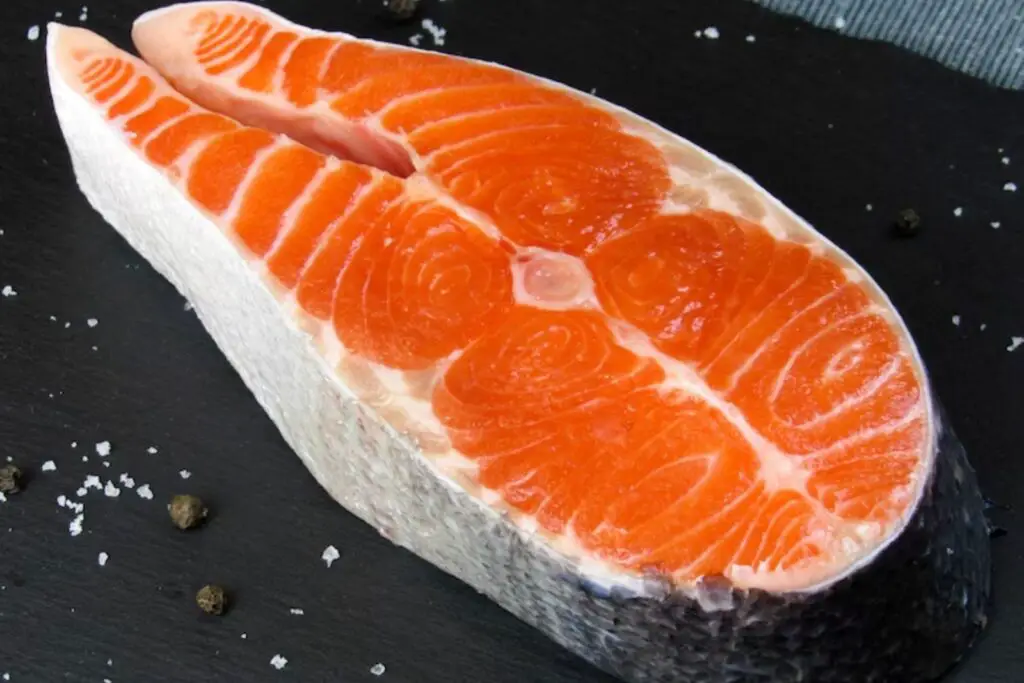
Catfish are a type of fish belonging to the order Siluriformes. They have long, whisker-like barbels around their mouths, giving them their name. Catfish can be found in freshwater, brackish, and saltwater habitats around the world. They have smooth, scaleless skin and come in various sizes and body shapes. Freezing catfish is an excellent way to preserve its freshness and have a delicious seafood option available whenever you desire.
Here’s how you can freeze fresh catfish effectively:
Step 1: Clean and prepare the catfish
When cleaning the fresh catfish, start by placing it on a clean cutting board or surface. Use a sharp knife to remove the scales by scraping gently against the grain, starting from the tail and moving towards the head. This process helps remove any rough or bumpy texture from the fish’s skin.
Next, make a shallow incision along the belly of the catfish and carefully remove the guts and internal organs. Use your fingers or a spoon to scoop out any remaining organs, taking care not to rupture the gallbladder, which can release bitter substances.
After gutting the catfish, rinse it thoroughly under cold running water. This step helps remove any blood, slime, or other debris that may still be present. Pay particular attention to the belly cavity and gills, ensuring they are thoroughly cleaned.
To enhance the cleaning process, you can also lightly rub the catfish with a brush or sponge to remove any stubborn dirt or slime. However, be gentle to avoid damaging the delicate flesh.
Can I freeze catfish without cleaning it first?
It is not recommended to freeze catfish without cleaning it first. Cleaning the catfish before freezing removes any impurities, bacteria, or unwanted substances from the surface of the fish. Additionally, removing scales and internal organs ensures better preservation and prevents potential off-flavors or odors during storage. Proper cleaning and preparation of catfish before freezing help maintain its quality and ensure safe consumption after thawing.
Should I remove the skin before freezing catfish?
Whether to remove the skin before freezing catfish is a matter of personal preference. The skin of catfish can help protect the flesh during freezing and retain moisture. However, some individuals prefer to remove the skin to enhance the texture or to use the skinless fillets in specific recipes. Consider your culinary preferences and intended use when deciding whether to keep or remove the skin before freezing catfish.
Step 2: Pat dry the catfish
Patting dry the catfish after cleaning is an important step in the freezing process. Excess moisture on the surface of the catfish can contribute to the formation of ice crystals when frozen. These ice crystals can cause cellular damage and affect the texture and quality of the fish.
By patting the catfish dry with paper towels or a clean kitchen towel, you remove the moisture that could lead to the formation of ice crystals. This helps preserve the natural texture and flavor of the catfish when it is later thawed and cooked.
Additionally, removing excess moisture before freezing can also prevent freezer burn. Freezer burn occurs when the surface of the food is exposed to air, causing dehydration and resulting in a dry, discolored appearance. By patting the catfish dry, you minimize the chances of freezer burn, ensuring that the frozen catfish maintains its quality for a longer period.
Step 3: Portion the catfish (optional)
Portioning the catfish before freezing is an optional step that can offer convenience when it comes to thawing and cooking smaller servings. By cutting the catfish into individual portions, you can have better control over the amount of catfish you want to use at any given time.
Portioning is particularly useful if you anticipate only needing a smaller amount of catfish for a specific recipe or meal. It allows you to thaw and use only the desired portion, while keeping the rest of the catfish frozen for future use.
When portioning the catfish, ensure that the sizes are suitable for your needs. Consider factors such as the number of servings you typically require, the recipes you plan to prepare, and the size of your freezer containers or bags. It’s recommended to have portion sizes that can be conveniently stored and thawed without excessive waste or difficulty.
Is it necessary to blanch or cook the fresh catfish before freezing?
Blanching or cooking fresh catfish before freezing is not necessary but can be beneficial depending on personal preference and intended use. Blanching, which involves briefly immersing the catfish in boiling water and then transferring it to an ice bath, can help preserve its color and texture. Cooking the catfish before freezing can simplify meal preparation later, as the fish will be partially or fully cooked and can be reheated or incorporated into recipes more quickly. Ultimately, the decision to blanch or cook the catfish before freezing depends on individual preferences and the desired outcome when thawed and consumed.
Step 4: Wrap the catfish
Wrapping the catfish tightly in plastic wrap is an important step in the freezing process. It provides a protective barrier that helps prevent freezer burn and maintain the moisture content of the catfish.
Freezer burn occurs when the surface of the food is exposed to air, leading to dehydration and the formation of ice crystals. By wrapping the catfish tightly in plastic wrap, you create a seal that minimizes air exposure, reducing the risk of freezer burn.
Furthermore, the plastic wrap helps retain the natural moisture within the catfish. Moisture loss can affect the texture and flavor of the fish when it is thawed and cooked. By securely wrapping the catfish, you help preserve its moisture, ensuring a more succulent and flavorful end result.
It’s crucial to cover the catfish completely, leaving no exposed areas to prevent air contact. Properly wrapping the catfish in plastic wrap provides a protective layer that safeguards its quality during the freezing process.
Step 5: Double-wrap with freezer-safe materials
Double-wrapping the catfish with freezer-safe materials, such as aluminum foil or freezer-safe bags, offers an extra layer of protection during freezing. This additional wrapping helps create a more secure and airtight environment for the catfish, minimizing the risk of freezer burn and preserving its quality.
Aluminum foil acts as a barrier, shielding the catfish from air exposure and temperature fluctuations in the freezer. It helps maintain a more stable temperature around the fish, reducing the chances of freezer burn and extending its freezer shelf life.
Using freezer-safe bags is another effective option. These bags are designed to be resistant to low temperatures and prevent air from entering. When properly sealed, they create a tight seal around the catfish, creating a controlled environment that maintains its freshness.
Are there any alternatives to plastic wrap and aluminum foil for wrapping fresh catfish for freezing?
Yes, there are alternatives to plastic wrap and aluminum foil for wrapping fresh catfish for freezing. One option is to use freezer-safe resealable bags or containers made of durable materials such as glass or silicone. These containers provide airtight seals and are reusable, reducing waste. Another alternative is freezer paper, which is specially coated to prevent moisture loss and freezer burn. It can be wrapped around the catfish and secured with tape or freezer-safe adhesive labels.
Step 6: Label and date the packages
Labeling and dating the packages of frozen catfish is a crucial step to ensure proper storage management and maintain food safety.
By clearly labeling each package with the contents, such as “Fresh Catfish,” you can easily identify what is inside without the need to open and inspect each package. This labeling helps save time and prevents unnecessary thawing of multiple packages to find the desired item.
Additionally, including the date of freezing on the label allows you to keep track of the storage time. It helps you identify how long the catfish has been in the freezer, ensuring that you can use it within the recommended time frame for optimal quality and safety.
Proper organization and inventory management are facilitated by labeling and dating the packages. It helps you rotate your freezer stock effectively, ensuring that older packages are used first before newer ones. This practice minimizes the chances of food waste and ensures that you utilize the frozen catfish in a timely manner.
Step 7: Place in the freezer
When placing the wrapped catfish portions in the freezer, it is important to ensure they are positioned flat. This arrangement offers several benefits for storage, stacking, and overall organization within the freezer.
Firstly, laying the catfish portions flat helps optimize space utilization. By positioning them in a flat orientation, you can maximize the available freezer space and efficiently store other items alongside the catfish.
Secondly, it facilitates stacking. When the catfish portions are flat, they can be easily stacked on top of each other without compromising their shape or quality. This stacking method saves space and promotes efficient use of the freezer’s vertical capacity.
Lastly, the flat arrangement allows for easier organization and retrieval. When the catfish portions are neatly stacked and aligned, it becomes simpler to locate and access specific packages when needed. This avoids the hassle of searching through a disorganized freezer and minimizes the risk of accidentally damaging or knocking over other items.
Other related questions
How long can fresh catfish last in the freezer?
Fresh catfish can last in the freezer for approximately 4 to 6 months. However, it is advisable to consume it within the first 2 to 3 months for optimal quality. Proper packaging, labeling, and storage at a consistent freezer temperature are crucial factors in maintaining the freshness and taste of the catfish during its freezer storage period.
How do I defrost fresh catfish?
To defrost fresh catfish, there are a few recommended methods. The safest and preferred method is to thaw it slowly in the refrigerator, allowing it to gradually defrost overnight or for several hours. Alternatively, you can use the cold water method by placing the catfish in a sealed plastic bag and submerging it in cold water, changing the water every 30 minutes until fully thawed. Avoid using hot water or microwaving as they can lead to uneven thawing and compromise the texture and quality of the catfish.
Can I refreeze fresh catfish?
It is generally not recommended to refreeze fresh catfish once it has been thawed. When catfish is thawed, it undergoes changes in its structure and can be susceptible to bacterial growth. Refreezing catfish increases the risk of texture deterioration, loss of quality, and potential food safety concerns. It is best to consume the thawed catfish promptly to ensure optimal freshness and minimize the risk of foodborne illness.
How do I know if the fresh catfish have gone bad after being frozen?
To determine if fresh catfish has gone bad after being frozen, there are a few signs to look for. Check for any noticeable changes in color, such as significant darkening or discoloration. Additionally, a strong fishy or unpleasant odor may indicate spoilage. Finally, examine the texture of the catfish for any mushiness, excessive sliminess, or freezer burn, which can affect the quality and taste. If you observe any of these signs, it is best to discard the catfish to avoid consuming spoiled seafood.
Can I freeze catfish that has been marinated or seasoned?
Yes, you can freeze catfish that has been marinated or seasoned. However, it is important to note that the texture and flavor of the catfish may slightly change during the freezing and thawing process. Marinated or seasoned catfish can be frozen by following the same steps for freezing fresh catfish, ensuring it is properly wrapped and sealed to maintain its quality.
Can I freeze catfish fillets and whole catfish using the same method?
Yes, you can freeze catfish fillets and whole catfish using the same basic method of wrapping and storing. However, there may be some slight variations in the wrapping technique depending on the size and shape of the fish. For catfish fillets, individually wrapping each fillet is recommended to prevent freezer burn, while for whole catfish, wrapping it securely in plastic wrap and aluminum foil or placing it in a freezer-safe bag will help maintain its quality during freezing.
Can I freeze fresh catfish that has been breaded or coated in batter?
It is possible to freeze fresh catfish that has been breaded or coated in batter, but there are a few considerations to keep in mind. The breaded or battered coating may become softer or less crispy after freezing and thawing. To minimize texture changes, it is recommended to partially cook the breaded or battered catfish before freezing, allowing for final cooking after thawing. Additionally, proper wrapping and storage are crucial to maintain the quality of the breaded or battered catfish during freezing, such as double-wrapping with plastic wrap and aluminum foil to prevent freezer burn.
Are there any special considerations for freezing fresh catfish from different sources (farm-raised vs. wild-caught)?
When freezing fresh catfish, there are some considerations to keep in mind depending on the source of the fish. Farm-raised catfish generally have a milder flavor and more tender texture compared to their wild-caught counterparts. Freezing can slightly affect the texture, so it’s recommended to use farm-raised catfish within three to four months and wild-caught catfish within six months to maintain the best quality. Additionally, proper cleaning and preparation are essential for both types of catfish before freezing to ensure the removal of any impurities and maintain their freshness during storage.








